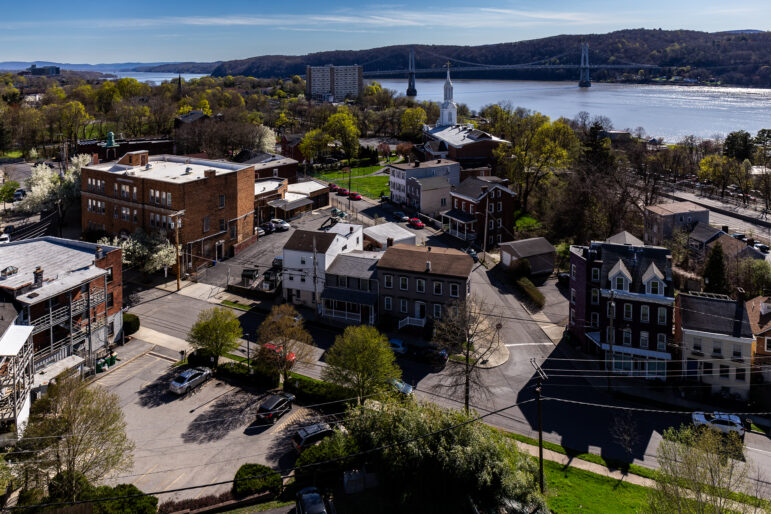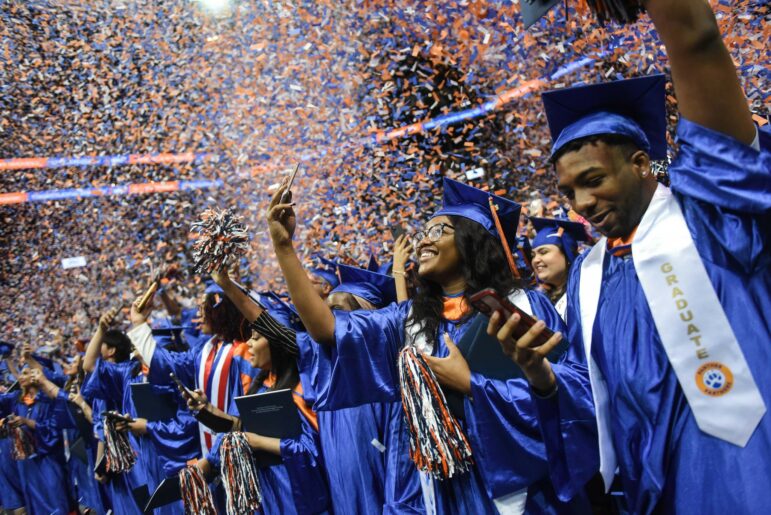“There were a lot of systems that weren’t working perfectly before COVID, and then during COVID really broke down and haven’t necessarily come back all the way,” Department of Social Services Commissioner Molly Wasow Park told City Limits in an interview Thursday.

Benny Polatseck/Mayoral Photography Office
Each January, teams of volunteers and city homeless outreach staff conduct the HOPE Survey in an effort to track the number of unsheltered people.The city’s annual estimate for its unsheltered homeless population—conducted each winter in an effort to track the number of New Yorkers sleeping on the streets and other public spaces—inched up to a near-record high this year, according to data released Thursday.
The 2024 Homeless Outreach Population Estimate (HOPE) Survey, carried out by volunteers and city outreach teams during a cold night in January, projected that there were 4,140 people experiencing unsheltered homelessness across the city, up slightly from 4,042 last year and the second highest number since the count began in 2005.
Advocates for the homeless stress that the survey is an imperfect tool, and say it’s almost certainly an undercount. This year’s uptick comes as New York City’s overall homeless population reached record highs, and more than doubled over the last two years. Around 147,000 people slept in the city’s sprawling shelter system in April—including nearly 66,000 migrants and asylums seekers, who began arriving in New York in larger numbers beginning in the spring of 2022.
But city officials said this year’s increase wasn’t driven by the new migrant population directly. While the HOPE Survey doesn’t seek or record information on people’s immigration status, the city paid close attention to counts around its migrant intake sites and emergency shelters, according to Department of Social Services (DSS) Commissioner Molly Wasow Park.
“We really haven’t gotten any sign of a systemic increase in asylum seekers experiencing unsheltered homelessness,” Wasow Park told City Limits in an interview Thursday.
This year’s numbers, she said, while up slightly, are fairly consistent what the city has seen in prior years (low counts during 2021 and 2022 should be considered anomalies, officials said, because of myriad factors associated with the COVID-19 crisis, including the state’s pandemic moratorium on evictions and federal funding at the time to place homeless New Yorkers in hotel rooms).
The population estimated by the HOPE Survey—which is required by federal law to take place at least every other year, though New York City does it annually—"have been failed by every level of government that there is, every form of the social safety net," Wasow Park said.
"They're not experiencing unsheltered homelessness in a vacuum. They're there as a result of all of these systemic failures. And there were a lot of systems that weren't working perfectly before COVID, and then during COVID really broke down and haven't necessarily come back all the way," she said, including New York's networks of inpatient psychiatric beds.
The city noted that its street homeless population is low compared to other major cities across the country, accounting for roughly 5 percent of the homeless population overall (in Los Angeles, by comparison, more than 70 percent of residents experiencing homelessness are unsheltered, according to DSS).
Wasow Park attributed this to the city's efforts to expand resources for street homeless New Yorkers, including increased outreach work conducted under Mayor Eric Adams' "Subway Safety Plan," and the opening of more than 1,100 Safe Haven and stabilization beds—which have fewer rules and barriers to entry than traditional shelters—since Adams took office. Another 500 such beds are expected to open by the end of the year.
She also pointed to the administration's focus on placing street homeless residents in permanent housing, saying they've done so for about 2,000 people so far, most of whom were connected with subsidized apartments.
"We used to essentially declare victory for an individual when we got them off the street and into some form of shelter," Wasow Park said. "Shelter is an important resource, but it's not the goal, right? The goal is permanent housing."
Advocates for homeless New Yorkers have long taken issue with the accuracy of the HOPE Survey. In a statement posted on social media Thursday, Coalition for the Homeless said the annual estimate "does not come close to representing the number of unsheltered people in our city, or the true scope of the homelessness crisis."
"The number of people who are sleeping unsheltered in New York City can vary very much from night to night, because people do whatever they can to get by," the group's executive director Dave Giffen told City Limits. "They might be in a shelter for some nights. They might find the shelters not meeting their needs and end up on the streets; they might be couch surfing; they might have made enough money to stay in a room for a few days."
He pointed to other numbers: the 9,231 people approached by city outreach teams at end-of-line subway stations from May 5, 2020 to Jan. 31, 2022, who accepted offers of transportation to shelters. Even that, he said, likely represents "a fraction of a fraction of a fraction," of the actual need.
"That was only the people who agreed to talk to outreach workers, and of those, it was only those that accepted referrals," he said.
Giffen attributed New York's relatively low unsheltered population compared to other major cities to its longstanding right to shelter protections, which requires the city to grant a bed, at least temporarily, to anyone who needs it.
The city temporarily amended those protections this spring, citing the strain on the shelter system as tens of thousands newly arrived immigrants sought beds. Under the new rules—struck as part of a legal settlement that Coalition for the Homeless helped negotiate—adult migrants without children are now subject to stricter 30- and 60-day shelter limits, and can only earn an extension if they meet specific criteria.
This means more people are now being "effectively denied shelter by the practices that [the city has] been undertaking," Giffen said.
Wasow Park countered that the administration is "absolutely not retreating from the right to shelter," arguing that the settlement made "a relatively small number of very time limited, focused adjustments to to how the right to shelter is implemented for this particular population."
"I'm not anticipating that we're going to see a big uptick in unsheltered homelessness as a result of the recent changes," she said, noting that migrants in shelter had already been subject to shelter limits when this year's HOPE Survey took place (though they faced fewer restrictions to extending their time then).
"But we will certainly monitor that closely," she added.
Additional reporting by Emma Whitford.
To reach the reporter behind this story, contact Jeanmarie@citylimits.org.









One thought on “City’s Yearly Street Homeless Estimate Climbs to 2nd Highest Number on Record”
With the lack of truly affordable housing it’s just going to get worse, shame on our politicians and greedy developer’s